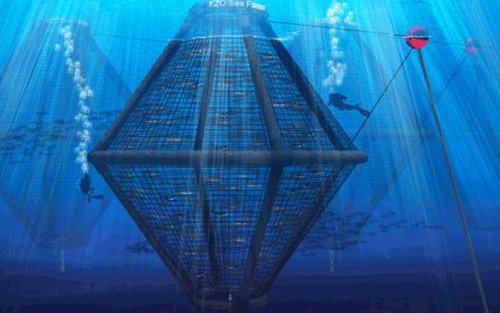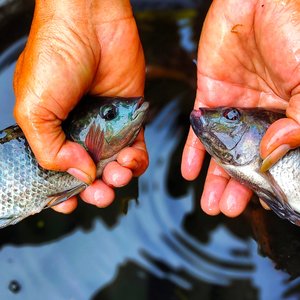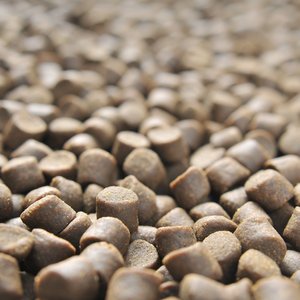Open-Ocean Aquaculture for the Arabian Sea
An artists rendering of an open-ocean sea cage used in deep water marine aquaculture.
By Phil Cruver
Global demand for food over the next 40 years is expected to double. Meeting this demand and achieving global food security will require, under present production technologies, a doubling of water consumption levels. Meanwhile, the chemically fueled “Green Revolution” has run its course, leaving soil moistures depleted, and unclear climate change patterns threaten a looming agricultural water crisis.
In many cases, wild fisheries around the world have reached or exceeded their maximum sustainable harvest; the United Nations is projecting a 40 million ton seafood shortage by 2030. The $50 billion worldwide marine aquaculture industry— the deliberate farming of ocean species that provides half the world’s edible seafood—is the fastest growing form of food production in the world. Seafood provides a valuable supplement for a diversified and nutritious diet. It provides not only high-value protein, but also represents an important source of a wide range of micronutrients, minerals, and fatty acids and amino acids. Since few precious and finite freshwater resources are required for farming fish from the ocean, seafood could be a solution for global food and water security.
Open-ocean marine aquaculture, the free range of the sea
Marine aquaculture has several advantages over traditional capture fisheries. Since cultured fish are kept in a relatively controlled environment, it is possible to monitor production and predict the output and harvest. This makes it possible to adapt the harvest according to market demand and ensure the right size, quality, and volume of the fish at the most opportune time. These factors result in lower production costs and higher profits.
Conventional aquaculture, however, has numerous challenges that must be addressed as well. Penning lots of fish together in farms generates waste from feces and unconsumed commercial feed. These wastes can carry disease and the phosphate and nitrates in the mix can cause algal blooms that suck oxygen from the water, leaving it uninhabitable. Conventional near-shore cages presently used in salmon farming have become excessively dependent upon pesticides and antibiotics to combat diseases that are rampant in highly concentrated farming conditions—not unlike industrial-scale hog, poultry, and cattle farming on land.
Shrimp farms similarly are frequently overharvested and depleted within in a few years in many developing countries, leading to a continuum of destruction of coastal areas. They also depend on staggering amounts of antibiotics, fungicides, algaecides, and pesticides, and are polluting and water intensive. Nearly half the loss of mangroves in the world has been attributed to unsustainable shrimp farming.
But new techniques being developed in open-ocean fish cultivation can address many of these problems. “Open-ocean” aquaculture is an emerging concept that uses submersible cages deployed in deep water to produce farmed seafood while minimizing the environmental footprint. Farming locations are sited where optimum currents and other favorable conditions soften the footprint on the sea. One might think of open-ocean aquaculture as analogous in some ways to free range in terrestrial farming.
Modern open-ocean techniques use integrated multitrophic aquaculture, or IMTA, to address several of the problems of conventional aquaculture. IMTA uses waste from one species, salmon and shrimp for example, as the food or fertilizer for other species such as shellfish and seaweed. Data show that when seaweed or kelp are grown near fish cages it absorbs much of the excess dissolved inorganic nutrients, such as nitrogen and phosphorus, and increases its biomass 46 percent faster than when grown about a mile away from the reference site. Meanwhile bivalve shellfish feed on the organic particulates and grow 50 percent faster. This accelerated growth turns the natural recycling into an economic benefit. Despite concerns that the shellfish and seaweeds might be reservoirs for diseases that could affect the fish, scientists in Norway and Canada have observed that, to the contrary, mussels act as a bio filter, destroying the viruses responsible for fish diseases, such as infectious salmon anemia.
Critics also assert that aquaculture doesn’t alleviate pressure on fish feed stocks because many species of farmed fish are fed fishmeal and fish oil. In response to this concern, many farming operations are using plant-based protein sources as a sustainable and cost-effective substitute or supplement to traditional fishmeal protein. Soy-based protein, for example, is a promising substitute because of its nutritional profile, low cost, and consistent availability.
Alternative protein sources already provide from one- to two-thirds of the dietary protein in commercial feed that is supplied for the cultivation of fish. Soy-based protein can provide up to 40 percent of dietary protein in fish feed without significantly affecting the feed conversion ratio, the protein efficiency ratio, or the net protein utilization—in essence, without impacting the health or nutritional value of the fish. In the laboratory, 100 percent replacement of fishmeal protein in feed has been achieved, but it is not yet considered cost effective for commercial-scale production.
In sum, when properly designed, open-ocean marine aquaculture has the potential to make aquaculture a sustainable source of protein for our globally growing population. The “Blue Food Revolution” published in Scientific American February 2011 provides a balanced view for sustainably feeding a future population of 9 billion.
“The reality begs for a comparison rarely made: fish farming versus terrestrial farming. Done right, fish farming could provide much needed protein for the world while minimizing the expansion of land-based farming and the attendant environmental costs.”
Indeed, according to Neil Anthony Sims, the founder of Kona Blue Water Farms, sustainably designed marine aquaculture systems have the potential to produce staple fish species with the same ecological impact as anchovies, which have minimal environmental impacts because they are very low on the food chain. The Scientific American article also quotes Jane Lubchenco, director of the National Oceanic and Atmospheric Association:
“One of my goals has been to get to a position where, when people say food security, they don’t just mean grains and livestock but also fisheries and aquaculture.”
A sustainable food source for the Arabian Gulf
Open-ocean aquaculture could play a big role in addressing the pressing food and water needs of the Arabian Gulf region. According to the International Fund for Agricultural Development, or IFAD, Arab Gulf countries account for more than 5 percent of the world’s population but less than 1 percent of global water resources. Because of the arid desert climate, which is not conducive to large-scale farming, the region imports more than 80 percent of its food. Furthermore, water used in agriculture consumes up to 80 percent of the total water supply; therefore, subsidized agriculture schemes are unfeasible and unsustainable on a large scale.
The Arabian Sea has great potential for open-ocean marine aquaculture development. With 1,700 kilometers of coastline, Oman has untapped potential to exploit this valuable resource with the development of a marine aquaculture industry. The 200-mile exclusive economic zone, extending seaward into the Gulf of Oman and Arabian Sea, presents a promising proposition for diversifying and augmenting Oman’s oil-based economy. Moreover, there is a strong commitment from the sultanate to develop the aquaculture sector in a competitive and sustainable manner in harmony with the social, economic, cultural, and historic values of the country.
With nearly 2,000 kilometers of coastline contiguously south on the Arabian Sea, Yemen is also endowed with rich and bountiful fishing grounds for feeding its burgeoning population. Like Oman, the fisheries sector lags far behind the oil and gas industry, suffering from lack of infrastructure, proper organization, and modern technologies.
Yemen could be the first nation to completely run out of water in a few years and Sana’a could be the world’s first capital city to go dry as people flee from the parched outer reaches of the country. Water available across Yemen amounts to 100 to 200 cubic meters per person per year, far below the international water poverty line of 1,000 cubic meters. Groundwater reserves are being used faster than they can replenish themselves, especially in the Sana’a basin, where water once found 20 meters below the surface is now 200 meters deep. The government is considering a desalination plant for seawater, an expensive solution that may come too late. Another option is to cut down on the agriculture industry and import even more food than its current 85 percent. The best option would be the development of a marine aquaculture industry.
Growing the marine aquaculture industry in these countries must leverage modern scientific knowledge and engage in diligent monitoring in order to avoid the ecological pitfalls that have plagued conventional fish farms around the world. The governments in Yemen and Oman have been actively engaged in ensuring both aquatic and terrestrial development is done sustainably, and both countries have frameworks that require environmental monitoring prior to licensing. “Oman’s Ministry of Environment and Climate Affairs in particular is known for its strict enforcement of environmental regulation,” says Tim Huntington, who works with the sultanate frequently as founding director of Poseidon Aquatic Resource Management LTD.
Done sustainably, a marine aquaculture industry for the Arabian Sea would increase food security and mitigate the depletion of sparse water for agricultural resources. It would also create jobs, generate income, and help increase nonpetroleum exports, while resuscitating local fish stocks to revive the livelihoods of fisher folks in coastal communities.
Phil Cruver is a progressive social entrepreneur and president of KZO Sea Farms.
This material "Open Ocean Aquaculture for the Arabian Sea" was first published by Science Progress








